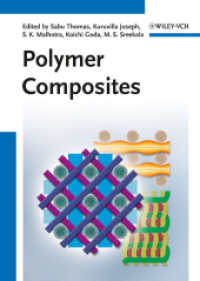- ホーム
- > 洋書
- > 英文書
- > Science / Mathematics
Full Description
Muons, radioactive particles produced in accelerators, have emerged as an important tool to study problems in condensed matter physics and chemistry. Beams of muons with all their spins polarized can be used to investigate a variety of static and dynamic effects and hence to deduce properties concerning magnetism, superconductivity, molecular or chemical dynamics and a large number of other phenomena. The technique was originally the preserve of a few specialists located in particle physics laboratories. Today it is used by scientists from a very wide range of scientific backgrounds and interests.
This modern, pedagogic introduction to muon spectroscopy is written with the beginner in the field in mind, but also aims to serve as a reference for more experienced researchers. The key principles are illustrated by numerous practical examples of the application of the technique to different areas of science and there are many worked examples and problems provided to test understanding. The book vividly demonstrates the power of the technique to extract important information in many different scientific contexts, all stemming, ultimately, from the exquisite magnetic sensitivity of the implanted muon spin.
Contents
1: The Basics of µSR
Part I: Elements of Muon Spectroscopy
2: Introduction
3: Muon Charge and Spin States
4: The Quantum Muon
5: Polarization Functions
Part II: Science with µSR
6: Magnetism
7: Dynamic Effects in Magnetism
8: Measuring Dynamic Processes
9: Superconductors
10: Semiconductors and Dielectrics
11: Ionic Motion
12: Chemistry
Part III: Practicalities of Muon Spectroscopy
13: Making Muons
14: Instrumentation
15: Doing the Experiment
Part IV: Further Topics in Muon Spectroscopy
16: Calculating Muon Sites
17: Numerical Modelling
18: Low Energy µSR
19: Stimulation Methods
20: High Magnetic Fields
21: Muons under Pressure
22: Negative Muon Techniques
Part V: Complementary Techniques
23: µSR versus Other Resonance and Bulk Techniques
24: X-rays, Neutrons, and µSR
Free







